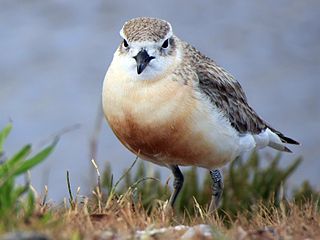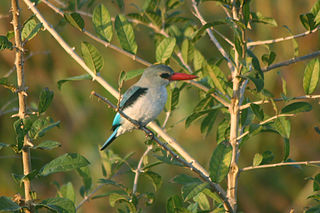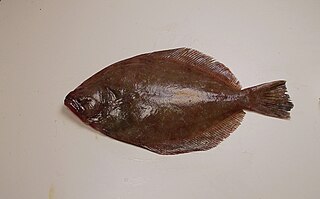
The New Zealand plover, also known as the red-breasted plover or New Zealand dotterel, is an endangered species found only in certain areas of New Zealand. Its Māori names include tūturiwhatu, pukunui, and kūkuruatu. There are two subspecies, C. o. obscurus in the South Island and C. o. aquilonius in the North Island. A 2015 study found its closest relatives to be other plovers found in New Zealand, the nearest the wrybill, which the study found to be in the Charadrius clade, and then the double-banded plover or banded dotterel.
The southern lemon sole, also known as the New Zealand lemon sole, is a righteye flounder, the only species in the genus Pelotretis, found around New Zealand in enclosed waters such as estuaries, harbours, mudflats, and sandflats, in waters less than 385 m in depth. Their length is from 25 to 50 cm.

The spotted estuary smooth-hound or rig is a houndshark of the family Triakidae, found on the continental shelves and in estuaries around New Zealand. It is closely related to the gummy shark of Australia. Males can grow up to a length of 125 cm, while females can reach a length of 151 cm.

The mangrove kingfisher is a kingfisher in the genus Halcyon. It is similar in appearance to the woodland kingfisher. It is found along the eastern coastline of Sub-Saharan Africa, living in woodland, along rivers, and in estuaries and mangrove. The International Union for Conservation of Nature (IUCN) has assessed it as being of least concern.

Pelecus cultratus, known variously as the sichel, the ziege, the sabre carp or sabrefish, is a species of cyprinid fish from an Eastern Europe and adjacent Asian regions. It is the only species of its genus. This species inhabits lower reaches of rivers and brackish waters of eastern Baltic, Black, Caspian and Aral Sea basins. This fish has no major threats and the IUCN lists it as being of "Least Concern".

The pied monarch is a species of bird in the monarch-flycatcher family Monarchidae. It is endemic to coastal Queensland in Australia.

The Solomons monarch, also known as the black-and-white monarch, is a species of bird in the family Monarchidae. It is endemic to the Solomon Islands. Its natural habitat is subtropical or tropical moist lowland forests. It is threatened by habitat loss.

Agonostomus telfairii, the fairy mullet, is a species of fish in the family Mugilidae, the mullets. It is known by the common name fairy mullet. It is native to the islands off the eastern coast of Africa, where it can be found in freshwater bodies and estuaries in Comoros, Madagascar, Mauritius, Mayotte, and Réunion. It returns to the sea to spawn.

The orange-spotted grouper, also known as the estuary cod, is a species of fish in the family Serranidae. It is found in the western Pacific, the Indian Ocean, and the Red Sea. It has also been recorded in the Mediterranean Sea as a Lessepsian migrant. Its natural habitats are subtropical or tropical mangrove, open seas, shallow seas, subtidal aquatic beds, coral reefs, estuarine waters, intertidal flats, and coastal saline lagoons. It is threatened by habitat loss and overfishing. This predatory fish reaches up to 1.2 m (3.9 ft) in length.

The Knysna seahorse or Cape seahorse is a species of fish in the family Syngnathidae. It is endemic to the south coast of South Africa, where it has been found in only three brackish water habitats: the estuary of the Keurbooms River in Plettenberg Bay, the Knysna Lagoon, and the estuarine portion of the Swartvlei system in Sedgefield. The limited range of this seahorse puts it at great risk of extinction.
The freshwater mullet is a species of fish in the Mugilidae family. It is endemic to South Africa.

The whitespotted whipray or sharpnose stingray is a species of stingray in the family Dasyatidae. It is found in coastal regions including estuaries, in the Indo-Pacific, and has also been recorded in the Ganges River. It reaches a maximum length of 2 metres. As presently defined, it is probably a species complex.

Paralichthys lethostigma, the southern flounder, is a species of large-tooth flounders native to the eastern and gulf coasts of the United States. It is a popular sports fish and is the largest and most commercially valuable flounder in the western North Atlantic Ocean and Gulf of Mexico. It is a "left-eyed flounder", meaning the left side is pigmented and is the "up side".
Enneacampus is a genus of freshwater pipefishes native to Africa.

The deep-bodied pipefish is a pipefish in the family Syngnathidae. These benthic fishes are found in estuaries and coastal waters of South America, from southern Brazil in the Atlantic Ocean to southern Chile in the Pacific Ocean.

The short-tailed pipefish is a species of fish in the family Syngnathidae. It is found in fresh and brackish waters from Sri Lanka and India east to southern Japan and the Society Islands. It inhabits places with little or no current in rivers, streams and estuaries.

The brown-bellied broad-nosed bat is a species of bat in the family Phyllostomidae. As a phyllostomid bat, it is characterized by a narrow uropatagium which is fringed with hair; a white dorsal stripe; large inner upper incisors convergent at the tips; and three upper and three lower molars. It is found in Guyana, Suriname, French Guiana, Trinidad and Tobago, northern Brazil, eastern Ecuador, and southern Venezuela. It is closely related to Platyrrhinus incarum and Platyrrhinus angustirostris.
The diamond mullet, is a species of mullet and is also known as the Ord River mullet. This species lives in both brackish or freshwater. Adult fish are found in estuaries, coastal waters and in some cases, ascending rivers into fresh water.

Tamarix canariensis is a species of flowering plant in the family Tamaricaceae. It is a shrub or small tree up to 4 m tall. It was previously said to be native to parts of Macaronesia, northern Africa and south-western Europe, but is now considered only to be found in the Canary Islands, the African and European species being Tamarix gallica. It was first described by Carl Ludwig Willdenow in 1816.

The corsula is a species of ray-finned fish from the grey mullet family Mugilidae. It is found in the rivers and estuaries of southern Asia, in India, Bangladesh, Nepal and Myanmar. It is presently regarded as the only species in the monospecific genus Rhinomugil.



















